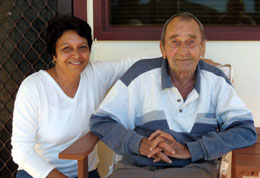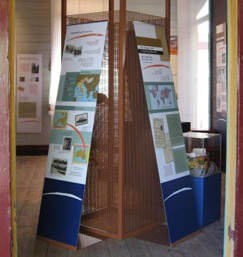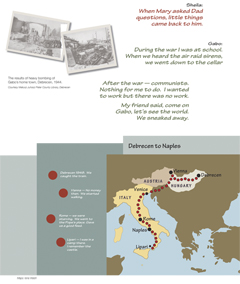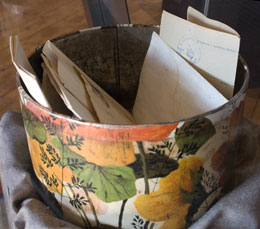| Lightning Ridge perspectives |
Gabor and Sheila Nagy: First and second generation perspectives
From Hungary 1949 to Lightning Ridge 1957
At the time of developing the exhibition Gabor Nagy, known to many as Gabo, was very frail but he and his family were interested in being part of the project. Gabo’s daughter Sheila worked closely with Mary to shape the story based on her father’s memory fragments, her own memories and Mary’s archival research. Gabo passed away in March 2008.
Mapping the personal, the local and historical
The map, documents and text that were developed for the exhibition, show Gabo’s migration from Hungary after the Second World War. At this time many Europeans whose countries had changed dramatically as a result of the War, responded to Australia’s new immigration program.
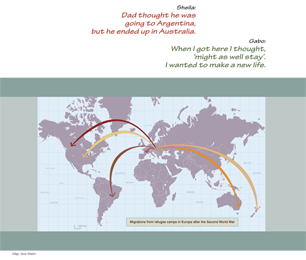 |
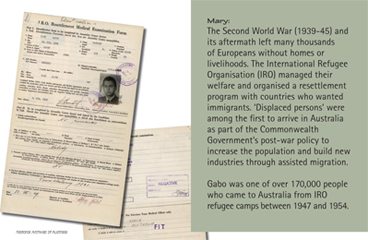 Details from Gabor and Sheila Nagy, panel one, Migration Memories: Lightning Ridge. Design: Iona Walsh. |
|
The local
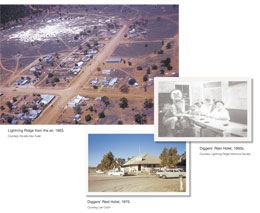 |
|
Detail from Gabor and Sheila Nagy, panel three, Migration Memories: Lightning Ridge. Design: Iona Walsh. |
It was town amenities, particularly the Lightning Ridge school, that took Gabo, his wife Ella and their young family to Lightning Ridge. Gabo and Ella exchanged their work as a husband and wife team on local pastoral stations, for work at the Lightning Ridge pub – the Diggers’ Rest. It was the early 1960s and Lightning Ridge was still accessible only by a dirt road.
The personal in historical context
Detail from Gabor and Sheila Nagy, panel two, Migration Memories: Lightning Ridge. Design: Iona Walsh. Click to enlarge. |
Gabo said that he wanted to ‘make a new life’. To show something of the ‘old life’ that prompted this decision, Mary, with the help of Gyorgyi Nyers, sourced photos of the devastating impact of the Second World War on Gabo’s home town of Debrecen. Another priority was to show the geography of the journey Gabo made from Hungary to Italy, mostly on foot, and his memories of it.
Looking back on the project
Mary
For the Nagy family, the process of developing Gabo’s migration story for the exhibition opened up a world of experience that Gabo had rarely mentioned. When I found his immigration documents at the National Archives, it was the first time his children had seen a photo of him as a young man. At home, the only visible signs of his connection with Hungary were a few documents and letters that were kept in a biscuit tin. Sheila and I decided to use the tin in the exhibition and discussed in detail how it would appear. All the same Sheila wasn’t prepared for how moving it was for her to see it in the exhibition. Nor was I.
Gabor's tin with letters on display, Lightning Ridge. Photograph: Ursula Frederick |
Sheila
I think the way you set the tin up was a bit touching for us… Probably because we just referred to it as a tin and had Dad’s stuff in it, but when you seen it open with the [facsimile] letters and that’s all he had of being home… when you think all you’ve got is a few letters of your past and it’s just in a tin. …Especially when, being my Dad and not knowing anything of his past… But I think since you’ve been talking to Dad and we’ve had little conversations about the things that you’ve asked him he does talk more about it now…[I feel] the sadness of what he had and what he’s got now, but the excitement of knowing more about him.

